管理学原理英文版第一章精品PPT课件
合集下载
管理学第一章ppt课件
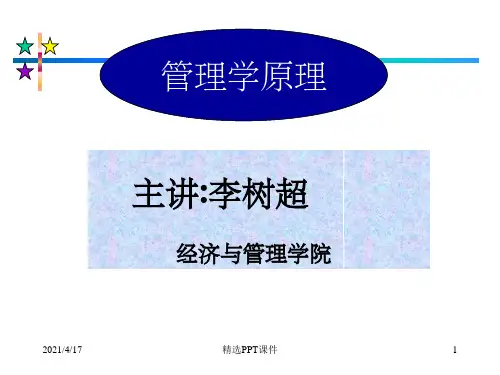
2021/4/17
精选PPT课件
6
为什么要学习管理学
4. 改进组织的管理方式关系到我们每个人的切身利益。 5.当你从学校毕业开始你的事业生涯时,你所面对的现实是,
不是管理别人就是被别人管理。作为管理者,理解管理过 程是培养管理技能的基础,可以使自己获得成为有效管理 者的系统知识。作为被管理者,学习管理可以更好地理解 上司的行为方式和组织的内部运作方式,适应组织的需要。
——针对案例、课堂讨论或感兴趣 的问题进行论述
2021/4/17
精选PPT课件
2
考核方式
期末考试(70%)
小论文(10%)
课堂参与(10%)
作业(10%)
2021/4/17
精选PPT课件
3
课程主要参考书
《管理学》[美]斯蒂芬·P ·罗宾斯 中国人民 大学出版社 《管理学》[美]哈罗德·孔茨/海因茨·韦里克 经济科学出版社 《管理学》原理与方法 复旦大学出版社
现在所谓的管理——从英语management翻 译过来的,manage,原意驾驭马匹,驯马, 引申为驾驭和驯服。
2021/4/17
精选PPT课件
19
管理是什么? ——解释二
管理者通过别人使活动完成得更有效的
过程——罗宾斯论
美国管理协会Management is the
accomplishment of results through the efforts of other people 余凯成:管理就是通过别人把事办成
管理存在于组织之中,是 为实现组织目标而服务的
管理 与 组织
2021/4/17
组织是管理的载体,管理依 存于组织的集体活动
管理没有自己目标,管理的目 的是为了实现组 织 的目标, 是实现组织目标的手段。
管理学英语ppt课件ppt课件
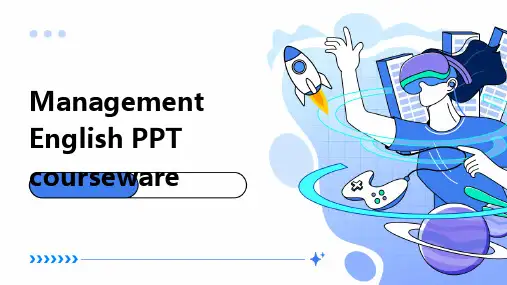
Risk control
Analyze potential risks, develop response measures, and ensure organizational safety.
Feedback and improvement
Collect feedback information, continuously improve management methods and processes.
Managerial Skills
Strategic vision
With a broad vision and the ability to plan for the long term.
Decision making ability
Scientifically analyze problems and make decisive decisions.
Communication and coordination skills
Good at communication and able to coordinate the interests of all parties.
Leadership
Unleash team potential and lead the team to grow together.
Establish an effective information communication mechanism to ensure the accuracy and timeliness of information transmission.
Leading
Motivation and Communication
管理学英文版-PPT课件
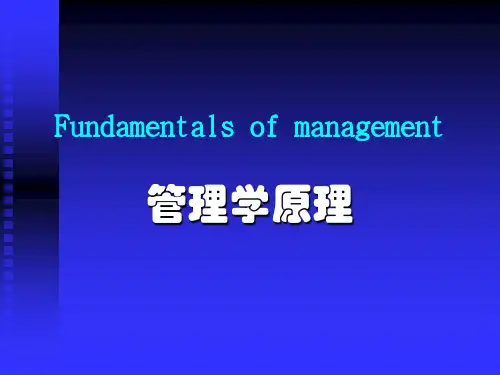
Globalization Ethnocentrism parochialism
Right or Rowing
企业已经缴纳教育附加税,因而没有义 务再资助办学。 援助灾民是企业的社会责任,因此,每 一个企业都必须进行赈灾活动。 在香烟外盒写上“吸烟有害健康”是毫 无意义的,因此是没有必要的。 既然政府的规定是50%,宝洁公司就没有 必要承诺100%的使用再循环包装纸。
Fundamentals of management
管理学原理
Chapter 1
manager and management
第一章
管理者与管理
Discussion 讨论
1961年,日本松下公司的山田电器厂遇 到了一个开关质量难题。实际上,这个 开关的装配操作很简单:从装有许多弹 簧的盒内每次取出两个装入开关,再装 上按钮。让山田厂长困惑的是,无论采 取什么质量管理方法,都不能使工人避 免偶尔忘记装入弹簧。 你能帮助山田厂长解决这个难题吗?
地区协调员
全球汽车 配件部
全球 工业部
全球仪器 产品部
全球原料 采购部
全球卡车 配件部
全球矩阵结构
国际执行委员会 业务领域 变压器 运输 德国 挪威 阿根廷/巴西 西班牙/葡萄牙
生产
当地公司
微软的组织结构
董事长/首席架构师:比尔•盖茨 CEO/总裁:史蒂夫•鲍尔默 营运和 后勤部 产品部门 全球销售、市场 和服务部 亚洲销售、市场 和服务部 亚洲产品 部门 微软在 中国的 机构 微软中国研究 开发中心
新闻发布,通报事项
Decisional 决策
Entrepreneur
企业家
制定战略,控制执行过程
管理学(英文版全套课件)
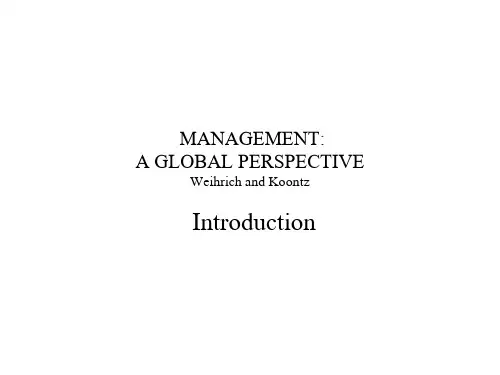
• Malcolm Baldrige National Quality Award established by the U.S. Congress in 1987 • ISO 9000, pioneered by the Europeans • European Quality Award given by the European Foundation
Arguments Against Social Involvement
• • • • • • • Violation of profit maximization Dilution of purpose Costs Too much power Lack of skills Lack of accountability Lack of universal support
• France
– Le Plan and the Cadre
• Germany
– Authority and Codetermination
• Korea
– Chaebol and Inhwa
Japanese Management
• Lifetime Employment • Seniority System • Decision Making in Japan
Chapter 2. Management and Society: The External Environment, Social Responsibility, and Ethics
The Organization and Its External Environment
Arguments for Social Involvement
Definition of Whistle-Blowing
Arguments Against Social Involvement
• • • • • • • Violation of profit maximization Dilution of purpose Costs Too much power Lack of skills Lack of accountability Lack of universal support
• France
– Le Plan and the Cadre
• Germany
– Authority and Codetermination
• Korea
– Chaebol and Inhwa
Japanese Management
• Lifetime Employment • Seniority System • Decision Making in Japan
Chapter 2. Management and Society: The External Environment, Social Responsibility, and Ethics
The Organization and Its External Environment
Arguments for Social Involvement
Definition of Whistle-Blowing
管理学原理(英文)(武汉理工)PPT全套课件
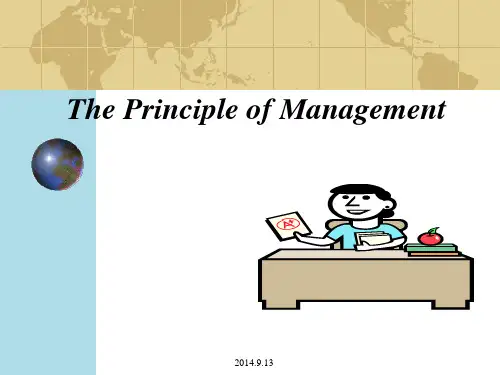
2014.9.13
Organizational Level
Responsibility
Making decisions about the direction of the organization and establishing policies that affect all organizational members.
2014.9.13
What is management?
Definition
The term management refers to the process of getting things done, effectively and efficiently, through and with other people. Several components in this definition need discussion. These are terms process, effectively, and efficiently.
Title
vice president/president/chancellor/ chief operating officer/ chief executive officer/ chairperson of the board Top department or agency head/ managers Translating the goals set by top project leader/ unit chief/ management into specific details district manager/dean/ Middle-line that rm bishop/division manager managers Directing the day-to-day supervisors First-line managers activities of operatives Operatives
管理学原理 英文版c11
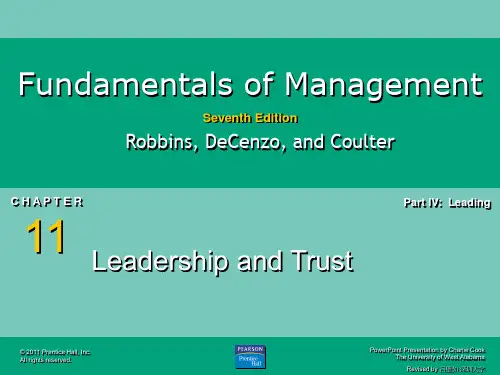
A leadership contingency theory that focuses on
followers’ readiness
• Readiness
The extent to which people have the ability and
willingness to accomplish a specific task
impoverished management
task management middle-of-the-road management
country club
team management
© 2011 Prentice Hall, Inc. All rights reserved.
such as hiring, firing, discipline, promotions, and salary increases
© 2011 Prentice Hall, Inc. All rights reserved.
Copyright © 2011 Pearson Education
11–15
freedom to make decisions and to complete their work however they see fit
© 2011 Prentice Hall, Inc. All rights reserved.
Copyright © 2011 Pearson Education
© 2011 Prentice Hall, Inc. All rights reserved.
Copyright © 2011 Pearson Education
11–7
followers’ readiness
• Readiness
The extent to which people have the ability and
willingness to accomplish a specific task
impoverished management
task management middle-of-the-road management
country club
team management
© 2011 Prentice Hall, Inc. All rights reserved.
such as hiring, firing, discipline, promotions, and salary increases
© 2011 Prentice Hall, Inc. All rights reserved.
Copyright © 2011 Pearson Education
11–15
freedom to make decisions and to complete their work however they see fit
© 2011 Prentice Hall, Inc. All rights reserved.
Copyright © 2011 Pearson Education
© 2011 Prentice Hall, Inc. All rights reserved.
Copyright © 2011 Pearson Education
11–7
罗宾斯《管理学》第十版 英文课件 第一章
Copyright © 2010 Pearson Education, Inc. Publishing as Prentice Hall
1–5
Classifying Managers
• First-line Managers
Individuals who manage the work of non-managerial employees.
• Middle Managers
Individuals who manage the work of first-line managers.
• Top Managers
Individuals who are responsible for making organization-wide decisions and establishing plans and goals that affect the entire organization.
1–11
What Managers Do?
• Three Approaches to Defining What Managers Do.
Functions they perform. Roles they play. Skills they need.
Copyright © 2010 Pearson Education, Inc. Publishing as Prentice Hall
1–8
What Is Management?
• Management involves coordinating and overseeing the work activities of others so that their activities are completed efficiently and effectively.
管理学原理1-2-PPT文档资料
Process - represents ongoing functions or primary activities engaged in by managers Coordinating - distinguishes a managerial position from a non-managerial one
copyright2019 金燕华
What Is Management?
Management
– the process of coordinating work activities so that they are completed efficiently and effectively with and through other people – elements of definition
Efficiency (Means)
Inefficient (few resources contribute to production) Not reaching goals and wasting resources Ineffective (little progress toward goals) Reaching goals and wasting resources
copyright2019 金燕华
第一章管理与管理学(4学时) 第一节 管理概述
一、管理的定义: 八哥的故事 1、中国古代:
– 管:钥匙,《左传.僖公三十二年》:“郑人使我掌其北门之管”, – 理:治玉,《韩非子.和氏》:“王乃使玉人理其璞,而得宝”
语源学: 管:上竹下官:竹:表示管辖的范围;管:人+权=官。 理--起源于虎额的“王”字和虎身有序的条纹,表示事 物的规律,上田(庄园)下土(道路),纷繁而不乱、有 序地进行管理,必要设定一些规律制度,乃“法”也。
copyright2019 金燕华
What Is Management?
Management
– the process of coordinating work activities so that they are completed efficiently and effectively with and through other people – elements of definition
Efficiency (Means)
Inefficient (few resources contribute to production) Not reaching goals and wasting resources Ineffective (little progress toward goals) Reaching goals and wasting resources
copyright2019 金燕华
第一章管理与管理学(4学时) 第一节 管理概述
一、管理的定义: 八哥的故事 1、中国古代:
– 管:钥匙,《左传.僖公三十二年》:“郑人使我掌其北门之管”, – 理:治玉,《韩非子.和氏》:“王乃使玉人理其璞,而得宝”
语源学: 管:上竹下官:竹:表示管辖的范围;管:人+权=官。 理--起源于虎额的“王”字和虎身有序的条纹,表示事 物的规律,上田(庄园)下土(道路),纷繁而不乱、有 序地进行管理,必要设定一些规律制度,乃“法”也。
英文版管理学原理,Principles od management 第一章
•First step –Drafting plans •Important aspect is creating
incentives that align employees’and organization’s interests
5
9/27/2007
1 - 11
Benefits & Incentives
1-8
Who Makes the Strategic Decisions?
By Senior Group including CEO With Formal Strategic Planning Process By Business Unit Leaders By CEO or Equivalent By Others
Source: Best of 2005, Business Week, December 19, 2005
7
Question
•Are the functions of management only for managers in organizations or can they apply to you as a student as well? Explain.
1. Describe the basic functions of management 2. Identify where in an organization managers are
located 3. Discuss the challenges people encounter as they
become first-line managers 4. Describe the roles managers adopt to perform the
incentives that align employees’and organization’s interests
5
9/27/2007
1 - 11
Benefits & Incentives
1-8
Who Makes the Strategic Decisions?
By Senior Group including CEO With Formal Strategic Planning Process By Business Unit Leaders By CEO or Equivalent By Others
Source: Best of 2005, Business Week, December 19, 2005
7
Question
•Are the functions of management only for managers in organizations or can they apply to you as a student as well? Explain.
1. Describe the basic functions of management 2. Identify where in an organization managers are
located 3. Discuss the challenges people encounter as they
become first-line managers 4. Describe the roles managers adopt to perform the
管理学原理(英文版)第一章课件FOM6CH
© 2008 Prentice Hall, Inc. All rights reserved.
1– 3
Who Are Managers And Where Do They Work?
• Organization组织
A systematic arrangement of people brought
Individuals in an organization who direct the
activities of others.
© 2008 Prentice Hall, Inc. All rights reserved.
1– 6
EXHIBIT 1–2
Organizational Levels
1– 5
People Differences
• Operatives作业人员
People who work directly on a job or task and have
no responsibility for overseeing the work of others.
• Managers管理员
Fundamentals of Management
Sixth Edition
Robbins and DeCenzo
with contributions from Henry Moon CHAPTER
Part I: Introduction
1
© 2008 Prentice Hall, Inc. All rights reserved.
Managers and Management
PowerPoint Presentation by Charlie Cook The University of West Alabama
- 1、下载文档前请自行甄别文档内容的完整性,平台不提供额外的编辑、内容补充、找答案等附加服务。
- 2、"仅部分预览"的文档,不可在线预览部分如存在完整性等问题,可反馈申请退款(可完整预览的文档不适用该条件!)。
- 3、如文档侵犯您的权益,请联系客服反馈,我们会尽快为您处理(人工客服工作时间:9:00-18:30)。
1-19
管理者应具备怎样的技能?
明茨伯格以及其他人描述了四项关键的管理技能
• 概念技能
– 用来分析复杂的形势
• 人际关系技能
– 用来沟通、激励、指导和委派任务。
ห้องสมุดไป่ตู้• 技术技能
– 基于工作领域内所要具备的专业知识
• 政治技能
– 用来建立权力基础和社会关系
Copyright © 2009 Pearson Education, Inc. Publishing as Prentice Hall.
– 例如,地区经理、部门经理
• 基层管理者
– 负责指导非管理类员工
– 例如,主管、团队领导
Copyright © 2009 Pearson Education, Inc. Publishing as Prentice Hall.
1-9
什么是管理?
• 管理
– 通过与其他人共同努力,既有效率又有效果地 把事情做好的过程
– 在一个组织中直接督导他人工作的那些人
Copyright © 2009 Pearson Education, Inc. Publishing as Prentice Hall.
1-6
Copyright © 2009 Pearson Education, Inc. Publishing as Prentice Hall.
Copyright © 2009 Pearson Education, Inc. Publishing as Prentice Hall.
1-2
谁是管理者?他们在哪里工作?
• 组织
– 将一些人系统地安排在一起,以达到某些特定 的目标。
• 组织的共性
– 特定的目的 – 在一起工作的人员 – 考虑周全的系统化结构
• 效果
– 是指做正确的事,通过做这些工作任务从而帮 助组织达到既定目标
• 效率
– 关注的是方法,即有效地使用人员、资金和设 备
Copyright © 2009 Pearson Education, Inc. Publishing as Prentice Hall.
1-10
Copyright © 2009 Pearson Education, Inc. Publishing as Prentice Hall.
1-14
Copyright © 2009 Pearson Education, Inc. Publishing as Prentice Hall.
1-15
图表1-4 管理的四项职能
Copyright © 2009 Pearson Education, Inc. Publishing as Prentice Hall.
组织的三个共性
Copyright © 2009 Pearson Education, Inc. Publishing as Prentice Hall.
1-5
管理者与非管理类员工的区别何在?
• 非管理类员工
– 直接从事某项工作或任务,不必负有责任去监 督他人工作的那些员工
– 例如,助理、团队成员
• 管理者
1-20
管理者的工作具有普遍性吗?
至此,我们把管理当作了一种普遍性活动进行了 探讨。可实际上,管理者的工作存在多个方面的 不同。
• 组织中的层级
– 高层管理者所做的计划工作比主管更多
• 营利性与非营利性
Chapter
管理者与管 理
Copyright © 2009 Pearson Education, Inc. Publishing as Prentice Hall.
学习目标:
• 识别谁是管理者以及他们在哪里工作 • 定义什么是管理 • 描述管理者的工作 • 解释为什么学习管理非常重要 • 描述重新塑造和重新定义管理的要素
1-11
图表1-3
效率与效果
Copyright © 2009 Pearson Education, Inc. Publishing as Prentice Hall.
1-12
管理者做什么?
根据法国工业经济学家 亨利·法约尔提出的管 理职能观点,管理者 要执行某些活动或者 职能
Copyright © 2009 Pearson Education, Inc. Publishing as Prentice Hall.
1-7
图表1-2
组织的层级
Copyright © 2009 Pearson Education, Inc. Publishing as Prentice Hall.
1-8
管理者在组织中的称谓是什么?
• 高层管理者
– 负责制定与组织发展方向有关的决策 – 总裁、副总裁、首席执行官
• 中层管理者
– 管理另外一些管理者
Copyright © 2009 Pearson Education, Inc. Publishing as Prentice Hall.
1-3
Copyright © 2009 Pearson Education, Inc. Publishing as Prentice Hall.
1-4
图表1-1
1-16
管理者的角色是什么?
明茨伯格指出,可以通过管理者在三类工作中所担 当的10种角色来描述他们的工作。
• 人际关系
– 代表人物、领导者和联络人
• 信息转换角色
– 信息监督人、信息传达人和发言人。
• 决策角色
– 企业家、危机处理者、资源分配者和谈判者
Copyright © 2009 Pearson Education, Inc. Publishing as Prentice Hall.
1-13
四项管理职能
• 计划
– 确定组织目标以及实现该目标的方法
• 组织
– 对组织结构进行安排和设计以实现组织目标
• 领导
– 指挥他人的工作活动
• 控制
– 监督、比较以及对工作执行过程进行纠偏
Copyright © 2009 Pearson Education, Inc. Publishing as Prentice Hall.
1-17
Copyright © 2009 Pearson Education, Inc. Publishing as Prentice Hall.
1-18
图表1—5
明茨伯格的管理者角色
Copyright © 2009 Pearson Education, Inc. Publishing as Prentice Hall.
